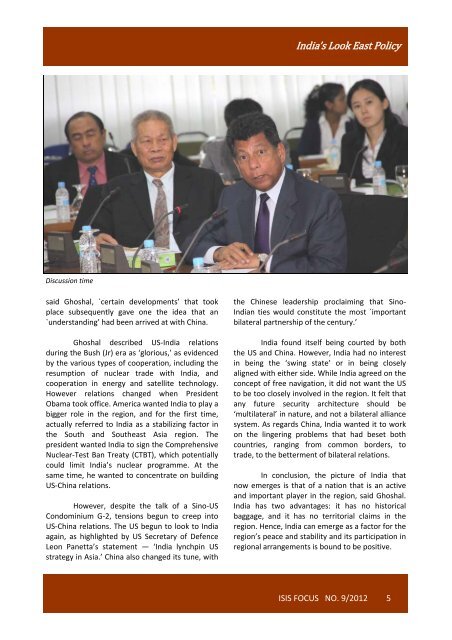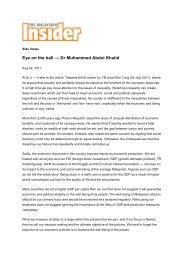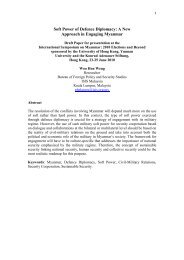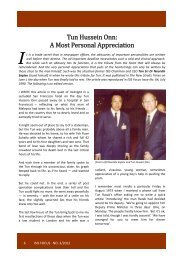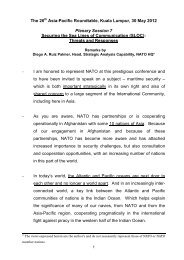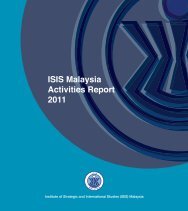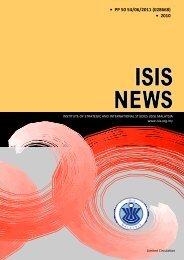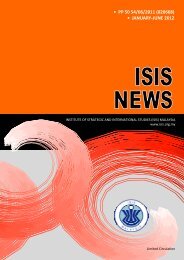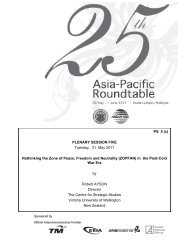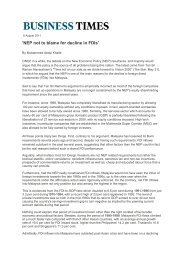India's Look East Policy - ISIS Malaysia
India's Look East Policy - ISIS Malaysia
India's Look East Policy - ISIS Malaysia
You also want an ePaper? Increase the reach of your titles
YUMPU automatically turns print PDFs into web optimized ePapers that Google loves.
India’s <strong>Look</strong> <strong>East</strong> <strong>Policy</strong><br />
Discussion time<br />
said Ghoshal, `certain developments’ that took<br />
place subsequently gave one the idea that an<br />
`understanding’ had been arrived at with China.<br />
Ghoshal described US‐India relations<br />
during the Bush (Jr) era as ‘glorious,’ as evidenced<br />
by the various types of cooperation, including the<br />
resumption of nuclear trade with India, and<br />
cooperation in energy and satellite technology.<br />
However relations changed when President<br />
Obama took office. America wanted India to play a<br />
bigger role in the region, and for the first time,<br />
actually referred to India as a stabilizing factor in<br />
the South and Southeast Asia region. The<br />
president wanted India to sign the Comprehensive<br />
Nuclear‐Test Ban Treaty (CTBT), which potentially<br />
could limit India’s nuclear programme. At the<br />
same time, he wanted to concentrate on building<br />
US‐China relations.<br />
However, despite the talk of a Sino‐US<br />
Condominium G‐2, tensions begun to creep into<br />
US‐China relations. The US begun to look to India<br />
again, as highlighted by US Secretary of Defence<br />
Leon Panetta’s statement — ‘India lynchpin US<br />
strategy in Asia.’ China also changed its tune, with<br />
the Chinese leadership proclaiming that Sino‐<br />
Indian ties would constitute the most `important<br />
bilateral partnership of the century.’<br />
India found itself being courted by both<br />
the US and China. However, India had no interest<br />
in being the ‘swing state’ or in being closely<br />
aligned with either side. While India agreed on the<br />
concept of free navigation, it did not want the US<br />
to be too closely involved in the region. It felt that<br />
any future security architecture should be<br />
‘multilateral’ in nature, and not a bilateral alliance<br />
system. As regards China, India wanted it to work<br />
on the lingering problems that had beset both<br />
countries, ranging from common borders, to<br />
trade, to the betterment of bilateral relations.<br />
In conclusion, the picture of India that<br />
now emerges is that of a nation that is an active<br />
and important player in the region, said Ghoshal.<br />
India has two advantages: it has no historical<br />
baggage, and it has no territorial claims in the<br />
region. Hence, India can emerge as a factor for the<br />
region’s peace and stability and its participation in<br />
regional arrangements is bound to be positive.<br />
<strong>ISIS</strong> FOCUS NO. 9/2012 5


